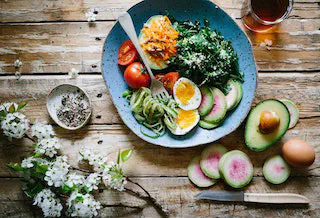
Finding the diet that works for you
- Matthieu P.J.
- Wellbeing
- January 25, 2021
“Let food be thy medicine, and let medicine be thy food.“
—Often attributed to Hippocrates
Looking back at my past, I had not formed the best habits for eating during my childhood and teenage years, and this led me to being unbalanced as a young adult when I finally lived by myself. Understanding how to feed properly and make my body feel happy and replenished after a meal has been a key milestone on my spiritual journey. I’d like to share some important insights I gathered over the years so it can help you too. I’ve also talked about my learnings in this short video .
Table of Contents
Food is your best medicine
As the famous introduction quote suggest—whether or not it was truly said by Hippocrates—there is in food the best medicine you can find. When you eat proper food regularly, you are much more likely to be in good health.
The problems with our modern food are multiple:
- an abundance of highly-processed food that has low nutritional value for the body
- most processed foods include high amount of sugar salt and fat. Sugar is the worst of all and literally a poison for your body
- over-consumption of meat, fish and dairy
- too many fried and greasy food (i.e. not with healthy fats)
- food that is not under its natural form but was transformed into a genetically modified organism (GMO)
- disproportioned ratios of Carbs vs Fat & Protein in the food intake
- excessive amount of grains—which are known to be bad for us in high quantity
- excessive consumption of what I call the unholy trinity: alcohol–caffeine–cigarette because they all mess up with your body
- food that was exposed to chemicals: fertilisers (plants) and antibiotics (animal)
- food that is travelling long distances (which impacts the environment by excessive transport and carbon footprint)
Then there are the bad habits:
- eating while doing something else
- going for the cheapest food available—even when highly processed and imported from the other side of the world
- loosing track of what seasons are for fruits and vegetables which means you end up buying food that comes from thousands of miles away
- compulsive eating when something’s upsetting you rather than addressing the frustration and your emotions
You can learn how to eat properly
We do not learn about nutrition at school and that’s a great disservice we make to our kids. There has been so much misinformation spread in popular culture about what is healthy and what is not that people must re-learn what is actually healthy for them. I can’t stress enough how important it is to invest in your health education and spend time reading and documenting yourself .
Today’s world is dominated by a handful of mega-corporation that decide the type of food available for millions of consumers. Most of the food they manufacture have something in common: they are high in fat (but often not the healthy ones), sugar and cheap carbs (e.g. wheat, corn, rice, potatoes). In the West, we’ve been so heavily influenced by the needs of the food industry that it’s become ridiculous. No, a bowl of wheat cereals with whole milk and granulated sugar on top is not the best you can give your child for starting the day. In fact wheat and milk are not good for us at all (and I’ll get back to that). They are in surplus in the modern food industry and much money has been spent on marketing trying to convince you that you should eat a lot of it. No, milk is not the best source of calcium—in fact many studies suggest it deprives the body of calcium because of all the other things it contains.
A key thing you need to understand is what’s the difference between carbs, fat and protein; and roughly how much of each your favourite food contains. Also realise that there are many fruits and vegetables out there you may not know which you can discover at your local supermarket: just get curious, it can even be fun to discover new flavours. And no, fries are not a vegetable.
The awful three
I want to get out of the way 3 types of food that you need to be aware of because they are source of problems for many people.
Refined sugar (plain toxic)
Sugar did not exist as such in man’s diet till recently. In nature, sugar is present in fruits and honey for example, but the modern version of granulated white sugar is something unnatural. Such refined sugar gives a high when you ingest it and your brain quickly becomes addicted to it. Yes, sugar is a free drug available over-the-counter; it can be as addictive as some street drugs because it triggers similar effects in the brain.
It not normal that sugar is in disguise in most processed foods. Sugar is highly addictive and destroys our bodies . Beware of sugar! It’s not so say you should never have any, but everything is about proportion. So when sugar is present in food over 10 percent, this is concerning—and I wouldn’t eat it unless it’s a treat like chocolate.
Modern wheat (genetically modified)
Modern wheat was the reason I was sick since my childhood. I had a life-long intolerance to wheat but I only self-diagnosed it in my late twenties—and this has changed my life. You can hear more about wheat in this video .
Modern wheat was heavily genetically modified and bare no resemblance with ancestral wheat. Modern wheat is very high in gluten and other proteins which are known to cause irritation of the bowel—many other pathologies. Whenever possible I’ll replace wheat by one of its ancestral cousins: khorasan (also called kamut) and spelt. If you can’t help but having wheat, try to keep it to once a day but really the less the better.
Milk (it’s for calves—not humans)
We apparently are the only species that drinks the milk of another species. Babies can be breastfed from their mother and that makes sense, but you wouldn’t give a woman’s milk to a calf, would you? Then why do humans drink cow milk at every age? Well, it’s cultural shall we say. Milk, yoghurt, cheese and the likes are part of local cuisine and not going away anytime soon.
Moderation is the key here. And if you’re feeling upset with milk, you can nowadays find affordable lactase tablets which will help your stomach cope with the lactose load when you eat dairy—and that is responsible for digestion issues for many people.
Forming healthy habits
- make your meal a ritual and give it your full attention (no TV, no call, no arguing with your partner, no browsing on your phone); feel what you eat, and take your time chewing on that food; bless your food for the energy it will provide you
- eat as many fruits and vegetables as you can—the 5-a-day rule is a good guideline although more won’t hurt!
- go for fresh, locally produced food especially fruits and vegetables; buy organic products whenever possible
- eat raw food e.g. salads and not only cooked food
- if you feel like you’re not really hungry anymore: stop eating! Break the pattern of compulsive eating
- learn to read the labels to understand what you eat and detect the sugar in disguise; develop an awareness of the rough ratio of carbs/protein/fat in each food you consume
- Don’t bother about the calories and counting them to the decimal. Use common sense: fats are high in calories (more than double of carbs or protein)
- if you want to change your body shape, be aware that you have an ideal weight and a frame structure that is genetic. Avoid comparing yourself to others, each body is different. What matters most is feeling at ease and content with how your body looks: the ‘feeling comfortable in your own skin’ idea
- know that you have the power to change the shape of your body. Millions of people have done it; I have done it; you can do it too!
- do not base the assessment of your progress only on the number the scale displays: your body is made of water (more than 50%) bones fat and muscle. Muscle is heavier than fat for the same volume. When you exercise, you maintain muscle mass or even gain muscle mass depending on the frequency and intensity of the workout. Therefore it’s entirely possible that you lose a few inches on your waist size while your overall body weight remains the same—or even increases. Trust your eyes as much as your scale.
- if you have any medical condition, you need to factor that into your strategy—and seek medical advice if you feel it’s needed
The importance of experimentation
There’s an endless list of diets out there, and some are just fads that will vanish before you know it. Let’s mention a few interesting ones: no carbs, low carbs, keto, paleo, Atkins, blood type.
Many people start a diet cyclically: they have reached a point when they don’t like their body weight anymore, they start a new diet as a way to fix that, they are serious for a while then they give up and usually regain the lost weight—or even a bit more. That type of cycles confuse the body more than anything else and I’d just abstain.
One thing though that diets have taught me is to understand the difference between the types of food. It’s actually during a no-carbs diet that I’ve identified my wheat intolerance. At the same time I realised that grains in general, while making me feel full, are actually not such a healthy food. But everybody has a different metabolism and tolerance for certain foods. So what I’d recommend is: have a go at some dissociated diet to feel the difference in your energy and well-being levels because most people have developed food intolerance but are blind about it till they withdraw then reintroduce the problematic foods. It’s part of the education process: that’s the practical work.
Being vegetarian or vegan… is that for everyone?
First I’ll mention what I call ’the myth of protein’ and that relates to the strong belief that our body needs a lot of protein to build and maintain muscle mass. There is certainly a big business around protein shakes for the sportsperson but that does not reflect our anatomy. We are not meant to ingest large quantities of proteins, our kidneys are too small for that. Lots of evidence suggest that we need moderate amount of protein instead. If you look at nature: gorillas are muscular but are mainly vegetarian! And if you look on the internet you’ll realise that there are many athletes that thrive on a vegetarian or vegan diet.
A trend in recent years has been the development of an impressive range of vegetarian or vegan meat and cheese in the average supermarket. That reflects a change of mentality where people diminish their intake of meat and dairy, which is probably a good thing.
But is the alternative possibly worse than the original food? When I read the labels of such substitute meat or cheese, I really wonder: they are replaced by high amount of carbs (modified starches of all sorts) and wheat or soya. It’s not because the supermarkets are flooded with such products that it makes them healthy!
Now I want to share my experience. I’ve never been a big meat eater, especially red meat, but I would eat meat and fish occasionally since a child. As an adult I’ve felt attracted to the vegetarian and vegan mindset and I’ve experimented for myself. I realised that vegan was too exclusive for me because I would occasionally have dairy and I love honey. Then I went for a vegetarian experience for about 2 years. It ended as I entered winter and realised that I would suffer mysterious cravings that could not be satisfied by any vegetarian food. Worse, I would binge on carbs and that would do me no good. Then in a matter of 2 weeks I received 3 different messages saying that I needed to eat meat and fish again and that this was the unidentified food my body was craving! I did. The first bite of meat brought back the memories of a strange feeling—that of a grounding energy. But that was OK. My cravings stopped within a few days. Since then I have meat or fish every few days or when I feel like my body asks for it.
I realised that my own experience getting back to meat was not unique: many people have been through similar phases. No matter how long they’ve been trying to be vegetarian (months, years or even decades), one day people may realise they need to fill a need their body has for animal product. And that’s fine!
I now look differently at claims that everybody must become vegetarian or vegan for the salvation of the planet. That seems excessive. It is for sure that in the West we tend to eat too much meat and animal products in general, but that does not mean we should go to the other extreme. I am very sensitive to the messages around animal cruelty, the carbon footprint of growing meat and the overall impact on the environment. And I think that as a participant into the economic system, I have the power to influence what is done by buying organic, ethical and high quality meat or fish whenever possible. But those who want to save the planet should not send messages of guilt and shame to meat eaters because that will not sort the issue of meat overconsumption in an elegant way.
More tips
Listen to your body!
Your body has an intelligence of its own and if you are attentive and connected to it, it can literally tell you what it needs. You can make an experience: walk down the aisles of supermarkets and ask your body what it wants to eat. When you look at some food, ask your body ‘do you want to eat that?’. You will get the answer in the form of a feeling or intuition. That works!
Similarly, if you have cravings for something—even for unhealthy food—you should not repress them. You can indulge in them, but obviously within reason and using your common sense. But if you have an overall healthy diet, having the weekly cheat meal with a bit of junk food cannot hurt you. Quite the opposite, it can help you keep a balance and avoid building up cravings that will lead to a relapse into permanent unhealthy eating habits.
Break a fast to reveal what ‘feels good’ when you eat
I already talked about fasting in a video , but here I want to touch on a way to use fasting to reveal what it is your body finds healthy and nourishing.
The first few times I fasted I was stunned at one thing: how my body reacted once I re-introducted food. For example fried food and junk foods e.g. fries or pizza were feeling wrong. On the other side, fruits and vegetables were pure delight! They were like raw nourishing energy I was just getting inside my own body.
It’s easy to lose track of what is really a nutritious food. But thanks to fasting, you can rediscover these sensations. For example: dead foods like carbs in bread, crackers etc. are not much satisfying. Even one day of fasting will help you, don’t feel like you need to go for very long (and actually you shouldn’t if you’ve never fasted).
So fasting has 2 virtues:
- it resets your body and your appetite so you can rediscover what it feels like when you are hungry—as opposed to eating compulsively when your body does not need food
- it informs you on the foods that are really good for your body—something you may have disconnected from at some point in the past
The tragedy of grains
Grains are mostly carbs and are NOT meant to be the main source of calories in man’s diet. Grains contain anti-nutrients and other molecules that are known to irritate our digestive tract and trigger allergies or intolerances.
Our ancestral diet was not including grains because they were only introduced after the advent of agriculture. That is actually the main tenet of the paleo diet: drop the grains, go for fresh vegetables and fruits and anything that the cavemen had access to.
Eating grains occasionally is not the problem. But when the carbs intake becomes essentially derived from grains then it becomes tragic because it can make people sick—and they have no idea about it. In Western food, wheat is cheap and used in bread, pizza, pasta and the likes; wheat is a staple food! It’s not normal that on average 80% of carbs in the Western diet are derived from wheat alone. Elsewhere you find other staple foods: rice in Asia, and corn in the Americas.
So a good advice is: diminish your overall calories intake derived from grains, and if you feel like eating grains then vary the type you use. Apart from wheat you also have: kamut, spelt, oat, rye, barley, corn, rice, millet, potatoes (technically not a grain but behaving very much like one); and these three common pseudocereals: buckwheat quinoa and amaranth.
Bring in the healthy fats!
One major misconception that plagued the consumers is the message that ’eating fat makes you fat’, which led to the development of an impressive range of low-fat food. That is nonsense! The devil is in the detail: the accurate statement should be ‘unhealthy fat, when consumed in high quantity or along with refined carbs or sugar, are likely to make you store fat in your body’. Note the difference.
Not all fats are created equal. The ‘good fat’ is guess what: good for you. In fact, if you are depleted from healthy fats your body cannot run properly. The food that makes you put on weight is SUGAR. Yes, whenever you eat sugar—and if you read above you’ve seen it’s added massively in all processed food—your blood sugar levels are impacted and you are going to store fat from whatever food you ingest alongside sugar. For example when you eat sugar with a lot of junk food then you will put on weight—and remember that sugar is also found in many drinks such as sodas and fruit juices. Considering most junk food contains sugar it is no wonder that lots of people become overweight or even obese. Developing awareness is what’s needed for breaking bad habits. French fries with lettuce and tomatoes won’t be that bad; but french fries with a ton of tomato and barbecue sauces (which are loaded with sugar) will do you no good.
Understanding this sort of things explains why the fad of ’low-fat’ food and diets is not targeting the real enemy—which is sugar. By the way, healthy fats include: olive oil, coconut oil, hemp oil, rapeseed oil.
It’s all about the ratios
Determining the ratio of carbs fat and protein in your food intake is essential to understand what you are really eating. Behind every food are these 3 components; no more, no less. Once you realise how the pie chart looks like in your current diet, you may want to adjust the ratios and align them with your body needs. In the West we tend to have a diet filled with lots of refined carbs and sugar, and unhealthy fats. This is the typical recipe for an epidemic of obesity—one which we have unfortunately been observing for many years now.
Everyone is different and needs to feel things for themselves, but the following ratios are an example where protein and fat have been increased to put carbs into balance.
- 40% carbohydrates
- 30% percent protein
- 30% percent fat
Final thoughts
Living in a healthy body is something everyone aspires to, yet many people seem unable to control how their body react to the food they ingest. This comes largely from gross misconceptions in popular culture and a lack of global understanding of the needs and capacities of the human body. There are some base concepts everyone should know about nutrition and that should also be taught in schools from a young age to improve public health. Seriously, what are we waiting for?
We all have different bodies and slightly different needs. There is no one-size-fits-all miraculous diet. The key is about BALANCE: having a variety of food which may or may not include meat and fish; keeping healthy ratios of carbs-protein-fat; going for the healthy foods; eating good portions but not in excess compared to our real appetite.
Finally, diet does not do everything. Exercising properly, moving your body, and keeping a healthy mind are also essential to have an overall good health.


